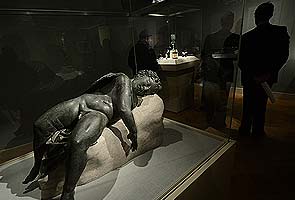
A new exhibit at the Metropolitan Museum of Art, "Changing Image of Eros, Ancient Greek God of Love, from Antiquity to Renaissance," demonstrates that love as we know it doesn't just last forever -- it's been around forever too.
The centrepiece of the exhibit, which opened last week and runs through June 23, is a remarkable, life size bronze sculpture of Eros shown as a sleeping baby.
Unusually for Greek art, the god's eyes are shut. And in a touching nuance, the baby's mouth rests open, while his left hand lies limp, having dropped his famous bow.
"He's in the midst of his labours and he's taking a nap," curator Sean Hemingway told sources.
Those labours, according to the Greek myth, were very much as doodling, love-sick teens might imagine them today: Eros firing arrows of love.
Less well known is that the Greek Eros had two arrows -- "either tipped with gold or tipped with lead," Hemingway said.
"The golden ones gave burning desire and the lead ones," he added with a chuckle, "repelled people from burning desire."
The image of Eros captured in the statue, which is dated to the 3rd-2nd centuries BC and comes from the island of Rhodes, spawned a remarkable dynasty of lookalikes, right from Roman art's Cupid to the winged cherubs of Renaissance paintings, and into our popular culture today.
But Eros wasn't always so cuddly. Until the period when winged babies came out with their darts of passion, the god was depicted in Archaic Greek poetry as a "powerful, often cruel, and capricious being," the exhibit explains.
The baby version meant love was "brought down to earth and disarmed."
"The idea of love is a universal concept," said Hemingway, an archaeologist and the grandson of the novelist Ernest Hemingway.
"For the Greeks, it was an important god and we continue to think of love, if not as a god, as important. Valentine's Day is coming up, so it's a good time to remember him."
Hemingway called the piece a "great masterpiece" that has always "fascinated" him.
It certainly fascinated the Romans, who made copies in large quantities, followed by the Renaissance artists whose rediscovery of Classical art inspired Europe's cultural explosion after the Middle Ages.
"He was rediscovered in the Renaissance early on," Hemingway said.
Incidentally, there's one more link between that ancient artwork and our modern cult of love: the statue's presumed birthplace.
Rhodes, Hemingway pointed out, "means 'rose' in Greek."
No comments:
Post a Comment